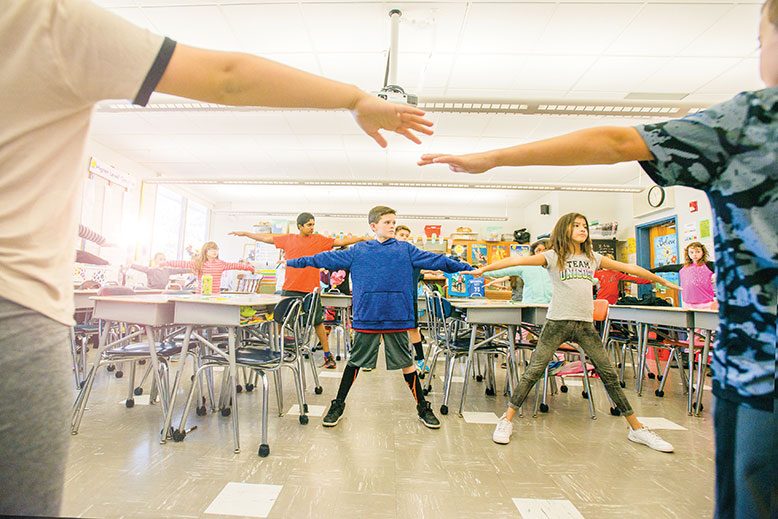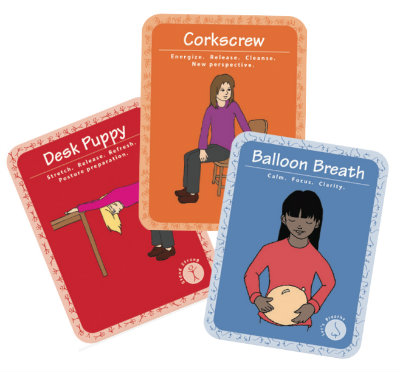
After a midday assembly at Woodland Elementary School in Monroe Township, the 20 or so fifth-graders file back into their classroom, chatting and giggling. Their teacher, Danielle Kutcher, asks them to take a seat, fold their arms and rest their heads on their desks. She presses play on a recording of gentle music—fitting for a spa—and starts to read from a big, purple card:
“Imagine there is a big, beautiful star above your head. It is glowing bright and shimmery, sending light out in every direction.” The room is calm and quiet, except for the music and the kids’ rhythmic breathing. Deep inhale, deep exhale. “Notice now that one of the biggest rays of light is streaming right down toward the top of your head. You feel the cozy, warm light touch the top of your head…relaxing all of your face muscles. Now the light is traveling into your neck…shoulders…and arms.”

Examples of Yoga 4 Classrooms activity cards
The children are enjoying an “Imagination Vacation,” the term for meditation used by Yoga 4 Classrooms, a company that provides activity cards with school-friendly lessons on yoga and mindfulness. The card used by Kutcher takes the children through a body scan, a type of guided meditation rooted in Buddhism that’s employed in Western yoga classes during transitions, usually at the beginning or end of class.
Schoolteachers frequently struggle to refocus a classroom after interruptions, such as an assembly, an announcement over the speakers, a fire drill, or the natural high from sweets at lunch and running during recess.
“We’ve always told our students to calm down, but we never tell them how,” says Kutcher, 44, who has taught fifth grade since 1998. “The kids say to themselves, “Okay, I don’t know what that means. I guess that means to sit here quietly.”
Social and emotional learning (especially how to self-regulate emotions and energy levels) are crucial for childhood development, but they take a back seat to math and language skills in the public school setting. “I’ve always felt there was a piece of puzzle, of educating the whole child, that was missing,” Kutcher says. “When I went to the [Yoga 4 Classrooms] weekend training, it completely changed my whole philosophy on how to educate children. It was that powerful.”
Four years ago, Kutcher began implementing what she had learned. “I saw an immediate, positive change in the students,” she says. “I saw changes in their self-perception; they were feeling better about themselves…and with this change came a readiness to learn. You have to have positive self-esteem for any learning to happen.”
Unlike a typical yoga class, there are no mats. “There is never a time where their hands are on the floor,” says Kutcher. Another difference is the language. Most yoga poses are referred to by their Sanskrit names in studio classes. For young children, imagery goes a long way. “Smell the flowers, blow out the candle,” is more effective than, “Inhale through your nose, exhale through your mouth.” (In Sanskrit, the practice of controlled breathing is called pranayama.) Yoga 4 Classrooms calls full, slow breaths, “balloon breaths”; the children are asked to imagine their stomachs as balloons. “Saying those phrases with younger students lets them visualize it and connect with it a little bit more,” says Kutcher.
Yoga 4 Classrooms is one of many programs emerging to bring mindfulness into K to 12 education. An Oprah magazine story about a Baltimore elementary school that replaced detention with meditation, causing suspension rates to plummet, went viral this past summer. Mindful Schools, another national program, has trained more than 10,000 educators to implement mindfulness lessons designed for under-resourced public schools facing high turnover rates and toxic stress.
“Private schools already have a lot of mindfulness and social- and emotional-learning programs,” says Maria Usewick, an occupational therapist and founder of Bridgewater-based Anchored Minds and Bodies. She is certified through Mindful Schools and travels around the state giving workshops to students and staff. “We’re trying to get more public schools interested.”
It’s hard for kids—and teachers—to escape anxiety in the classroom, a fact of life only exacerbated by the increase in standardized testing. “The kids regulate to the teacher, so a very stressed teacher will frequently have a very stressed classroom,” says Trish Miele, who taught third grade in the West Windsor Plainsboro public school district for 10 years until standardized testing changes, mounting administrative paperwork and student unease prompted her to quit. Many of her students felt pressure to perform and some were medicated for anxiety. “The district is very high-achieving,” says Miele, who is now certified through Mindful Schools. “I would have kids coming to me when we started doing testing, [saying], ‘If I don’t do well, I won’t get into Princeton!’ And I’m like, ‘You’re eight. What are you worrying about?’”
Now Miele trains students to use mindfulness techniques before testing. “They now understand freezing up is their brain freaking out, and that it isn’t a character flaw,” she explains. “It’s actually a reactive state, wired because they are scared, nervous and afraid.”
In a study published in the 2013 issue of the Journal of Educational Psychology, 87 percent of sampled elementary-and secondary-school teachers who received mindfulness training to reduce teacher stress and burnout found the program beneficial. Miele compares teachers using mindfulness in the classroom to using an oxygen mask on a plane. “Take care of yourself first,” she says. “Instead of saying ‘Settle down’ 14 times, everybody sits and does mindful breathing for a minute. It’s so much easier.” At the same time, mindfulness breaks create “a more collaborative and cooperative classroom environment.”
Anxiety can come from many sources at school—not just academic and administrative pressure. Jason Suleski, a social worker at the Millstone Township Primary School, says his school started looking into mindfulness after the mass shooting at Sandy Hook Elementary School in Newtown, Connecticut. “This was becoming something we were seeing more and more, and increasing the stress level of students.”
The Village Charter School in Trenton introduced mindfulness as a way to cope with what the head of school at the time, Dale Caldwell, calls urban traumatic stress disorder, a term he coined to describe the chronic anxiety felt by his inner-city students. “So much of their life is living on the edge of stress,” says Miele, who helped lead the Village Charter mindfulness workshop. “It could be food insufficiency, it could be general safety, not having a home, it could be abusive.… So many things are coming at them in the urban environment.”
A large component of mindfulness training is understanding the difference between reacting and responding: One is impulsive, the other intentional. “For me, it’s really about personal empowerment and about choice, especially for the urban kids,” says Miele. After learning mindfulness techniques, the Trenton students “started to really have power around their ability to choose, and just pause and make a decision about what they are going to say or do, instead of just reacting.”
At Mountain View Middle School in Mendham, educator Mary Lea Crawley of Madison-based Mindful Kids was invited to give a four-day workshop on mindfulness as part of the school’s anti-bullying programming. “Kids are really hungry for these tools,” says Crawley. “They want to be able to focus and make a better decision in the heat of the moment.”
Brooklake Elementary School in Florham Park implemented mindfulness and Yoga 4 Classrooms lessons starting this academic year. In Rebecca Corregan’s third-grade class, recent assignments included handouts like the “Frustration Station,” which asked students to draw things that make them frustrated and then write a sentence about what makes them feel better in those situations. One student drew her older brother stealing her iPad and then wrote how she’s learned to handle her frustration: “Take a deep breath and play with my puppy.” Nearby, Chatham Middle School added a mindfulness room (nicknamed Just a Little Breathing Room) for the students to use as needed.
“Parents are completely surprised that we have programs like this,” says Suleski, referring to Yoga 4 Classrooms. “And they are right…. We’re fortunate here in Millstone that we support this type of thing.”
In Monroe Township, Kutcher says the feedback from parents has been gratifying. She recalls a class mom who pulled her aside during a school fundraiser. “She had tears streaming down her face and said, ‘I’m not quite sure what this program you’re doing is about, but I want to thank you.’ And she hugged me. I got chills. I asked what was going on. She said, ‘I always had to battle my son to do homework, but now I watch him get up from the table, take a balloon breath, stand in mountain pose for a moment or two, and then he goes right back.’ She said, ‘I started to do it too. I started to take these breaths at work and do methods at my desk, and now my son feels like a rock star, because he’s teaching mom.’”
Whatever the age, the lessons are invaluable, says Kutcher. “This is going to carry them through their lifetimes.”

Great article! We are glad to see yoga and mindfulness being integrated into New Jersey schools! For a great article on introducing kids to yoga, check out http://www.kareboost.com/blog/5-reasons-to-introduce-your-kids-to-yoga.